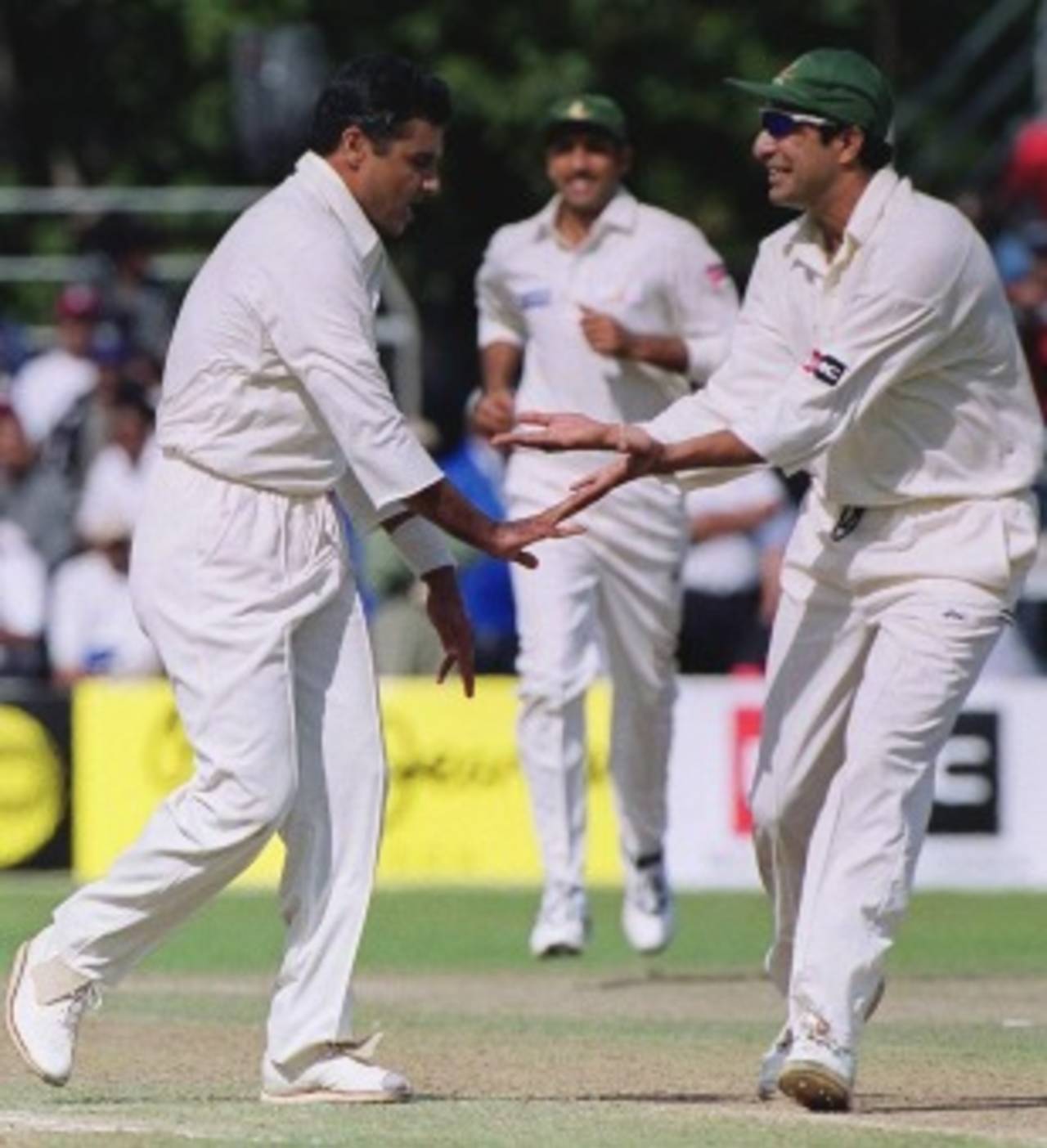Seven men bowled, and Yousuf's purple patch
Also: most economical figures in ODIs and T20s, stumped in the first over of a Test, 100 wickets at a venue, and longest wait to complete a hat-trick

Wasim Akram and Waqar Younis took over 100 ODI wickets each in Sharjah • AFP
India did lose seven men out bowled in the first innings of the first Test against Australia in Chennai, and while it's not a record, it was fairly noteworthy, as it was the first time it had happened since seven England players were bowled against South Africa in Port Elizabeth in 1999-2000 - more than 13 years and nearly 600 Test matches previously. The overall record is nine, set in the days when defensive techniques (and pitches) were not quite what they are today, by South Africa against England in Cape Town in 1888-89; it was equalled by Australia against England at The Oval in 1890. There have also been six instances of eight men being bowled in a Test innings (the last by England against New Zealand in Wellington in 1950-51). For the full list, click here.
Mohammad Yousuf's purple patch in that period actually brought him 2011 Test runs in 20 innings - which included ten centuries, two of them doubles. Thanks to my Wisden colleague Harriet Monkhouse, I can confirm that the only man to have scored more Test runs in a stretch of 20 innings in mid-career was the man you might expect - Don Bradman. He had quite a few brackets of 20 innings in which he was over 2000, the peak period being between his seventh and 26th Test innings, which yielded 2387 runs. That particular sequence included nine centuries, but one of them was a triple (334 at Headingley in 1930), one of them very nearly was (299 not out against South Africa in Adelaide in 1931-32), and four of the others amounted to more than 200 each. In that spell the Don averaged 132.61 (Yousuf's average was 105.84).
The most economical ten-over spell in one-day internationals was sent down by Phil Simmons, the West Indian medium-pacer, who conceded only three runs in his ten overs against Pakistan in Sydney in 1992-93, finishing with the remarkable figures of 10-8-3-4. A rather more predictable West Indian comes second on the list: Curtly Ambrose returned 10-5-5-1 against Sri Lanka in Sharjah in October 1999. In the 1975 World Cup, when the bowlers were allowed to deliver 12 overs, India's Bishan Bedi finished with 12-8-6-1 against East Africa at Headingley. In T20 internationals, five bowlers have conceded only six runs from their full four overs: Prosper Utseya for Zimbabwe against Pakistan in King City in October 2008; Chris Mpofu and Ray Price for Zimbabwe, both in the same match, against Canada in King City in 2008 (the day after Utseya set the record); Daniel Vettori for New Zealand against Bangladesh in Hamilton in February 2010; and Sulieman Benn for West Indies against Zimbabwe in Port-of-Spain later that same month. Price and Benn delivered two maidens, Utseya and Vettori one, and Mpofu none.
Alastair Cook's dismissal - stumped Dhoni bowled Ashwin - in England's second-innings run-chase in Kolkata in December appears to be only the second time a batsman has been stumped in the first over of any Test innings. The other instance was also by an England batsman, nearly 118 years previously - in the fourth Test of the 1894-95 Ashes series, Archie MacLaren was stumped by Affie Jarvis off the bowling of Harry Trott in the opening over of England's first innings in Sydney. It was an eventful series for MacLaren: in the second match, in Melbourne, he had become the first man ever to be dismissed by the very first ball of a Test (by Arthur Coningham's first delivery in Test cricket). However, in the final Test - by now not opening - MacLaren made 120 as England pinched the series 3-2.
You're right, Muttiah Muralitharan's best haul on one ground in one-day internationals was 82, in Sharjah: he also took 75 at the Premadasa Stadium in Colombo. But there are two bowlers who did take 100 one-day wickets at a single venue (the same one, as it happens): Wasim Akram took 122 wickets and Waqar Younis 114 in Sharjah. Your question suggests that you know it's a different story in Tests: Murali took a whopping 166 wickets in 24 matches at the Sinhalese Sports Club in Colombo. He also took 117 wickets in Kandy and 111 in Galle - next comes Heath Streak, with 83 Test wickets at the Harare Sports Club. For the full one-day list, click here.
Ryan Harris' late strikes took Queensland to a narrow victory over Victoria in the Ryobi Cup final in Melbourne last week. But the bad news for Harris is that, while a hat-trick can be split over two innings (like, for example, Merv Hughes' in the 1988-89 Perth Test against West Indies), it isn't officially considered a hat-trick if you take three wickets in successive balls across separate matches. If it were possible, then the longest wait was probably mentioned in last year's Wisden: the obituary of the Yorkshire slow left-armer Joe Johnson, who died in 2011 aged 94, pointed out that he had taken wickets with the last two balls of his first-class career, in August 1939: "The Second World War meant he never played again, so he remained on a hat-trick of sorts for the last 71 years of his life."
Steven Lynch is the editor of the Wisden Guide to International Cricket 2013